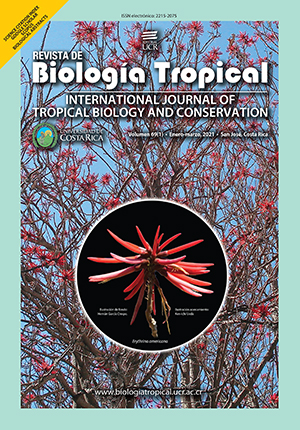Abstract
Introduction: The enemy hypothesis postulates that gall traits protect galling insects against natural enemies. Galls show a huge range of sizes, colors and ornaments, which vary even intraspecifically. However, galling insects are targets of various organisms that attack them directly or indirectly. In this context, to consider only one gall trait to investigate gall structure acting against only one guild of enemies can conceal an understanding of the community-level interactions. Objective: Herein, we take these ideas into consideration to investigate the conspicuous galls induced by Palaeomystella oligophaga Becker and Adamski 2008 (Lepidoptera) on Macairea radula (Bonpl.) (Melastomataceae) as a model system. We characterize this system through categorization of the different enemy guilds present in the community. We identified them to the lowest taxonomic level possible and determined the kind of interaction responsible for galling insects’ deaths. Considering the enemy hypothesis and the selection of secondary characteristics, we also aimed to determine which of the multiple gall traits influence the survival success of galling insects in a multi-enemy context. Methods: We inspected galls and characterized the enemy guilds affecting the galling insect and the mortality rates produced by each one of them. Next, we tested whether the distinct gall traits measured (parenchyma thickness, color, projections) promote galling insect survival with respect to each enemy. Results: The mortality induced by indirect enemies (organisms that interact with gall tissues and can interact secondarily with galling insect) was 47.3 %, being higher than that caused by parasitoids and predators (31.5 %). Despite the gall’s structural complexity, live galling insects showed the smallest occurrence (21.2 %). Parenchyma thickness was negatively related to Calliephialtes parasitoids, Gelechiidae cecidophages and predation signals. Conclusions: We demonstrated that the attacks to gall tissues by the cecidophages represented the highest threat to P. oligophaga survival, being higher than the mortality caused by direct enemies. That is, the gall traits were not as efficient as supposed to protect the galling insect from the attack of natural enemies. Nevertheless, we also demonstrated that parenchyma thickness can be negatively related to some organisms, especially direct enemies. Other traits hypothesized as defensive (e.g. projections, coloration) may simply play no role.
##plugins.facebook.comentarios##

This work is licensed under a Creative Commons Attribution 4.0 International License.
Copyright (c) 2021 Uiara Costa Rezende, João Custódio Fernandes Cardoso, Paul Hanson, D. C. Oliveira



